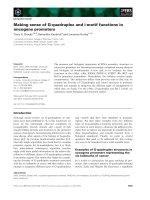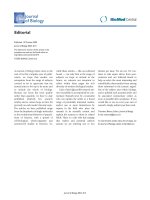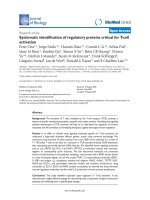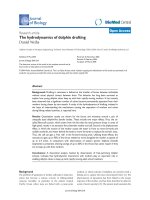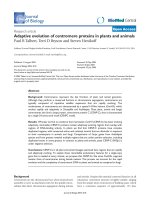Báo cáo sinh học: "Making sense of centromeres" doc
Bạn đang xem bản rút gọn của tài liệu. Xem và tải ngay bản đầy đủ của tài liệu tại đây (66 KB, 4 trang )
At the pinched waist of each eukaryotic
chromosome is a region that is
both elusive and enigmatic. Despite
considerable effort, and multiple
announcements of completed genome
sequences, this zone stubbornly
refuses to reveal its complete sequence,
and what little we know of it at first
sight runs counter to standard theories
of evolution. The region in question is,
of course, the centromere.
Back in the 1880s, scientists
worked out that centromeres played a
critical part in helping cells get their
fair share of chromosomes during cell
division, and we now know that it is
at these sites that spindle micro-
tubules attach. “It’s not just another
intriguing organelle that we would
like to understand; it is central to
eukaryotic biology,” claims Steven
Henikoff, researcher in the Basic Sci-
ences Division of the Fred Hutchinson
Cancer Research Center, Seattle, and
senior author of the study of cen-
tromere protein evolution published
in Journal of Biology [1] (see the ‘The
bottom line’ box for a summary of the
work). In prokaryotes, chromosome
segregation at division occurs simulta-
neously with DNA replication, whereas
in eukaryotes the two processes occur
at different points in a complex cell
cycle. And while the rest of the chro-
mosome’s DNA is packaged away and
consequently ‘silenced’ during mitosis,
the centromere alone remains active in
directing chromosomal movement.
Research news
Making sense of centromeres
Pete Moore
BioMed Central
Journal
of Biology
Comparative analysis of the proteins that bind exclusively at the centromere provides evidence
of an evolutionary battle that may make sense of sex.
Published: 31 August 2004
Journal of Biology 2004, 3:16
The electronic version of this article is the
complete one and can be found online at
/>© 2004 BioMed Central Ltd
Journal of Biology 2004, 3:16
The bottom line
• Centromeric DNA is highly repetitive and is therefore difficult to
sequence. It is also highly variable between species, which is surprising
for a region with an essential function.
• Comparative analysis of centromere-specific DNA-binding proteins,
such as CenH3 and CENP-C, across species can provide insights into
the evolution of centromeres.
• Although CenH3 is adaptively evolving in Arabidopsis and Drosophila,
there is no evidence of this in grasses and mammals. Instead, there is
strong evidence of adaptive evolution in distinct regions of the
centromere-binding protein CENP-C in plants and mammals.
• In contrast, yeast CENP-C is under negative selection, perhaps
reflecting the simpler organization and lower inter-species variability of
the yeast centromeric DNA to which it binds.
• ‘Centromere drive’, or the unequal transmission of competing
centromeres in female meiosis, may account for the rapid evolution of
complex centromeres in plants and animals. CENP-C, and some
CenH3 proteins, may undergo positive selection to suppress this
centromere drive. The absence of this drive process in yeast accounts
for its centromeric stability.
“The centromere is unique in eukary-
otic biology - there is nothing else like
it - and when we look at its evolution
we find that there is nothing like it
either,” says Henikoff.
While the exact detail of the DNA
sequence at the centromeres (see the
‘Background’ box) is unknown, it is
clear that the DNA is highly variable at
this region both in sequence and in
amount - so much so that centromere-
specific DNA in the human Y chromo-
some varies in size by one order of
magnitude between people, a feature
that is also sometimes seen in other
chromosomes. “The paradox is that
normal expectations of evolutionary
biology say that a region with such a
critical and highly conserved function
should have a stable sequence,” says
Kevin Sullivan, in the Department of
Cell Biology at The Scripps Research
Institute, who has been working on
the structure and function of cen-
tromere proteins for 15 years. One
would expect the DNA sequence to be
passed on almost unchanged from
individual to individual and even
from species to species. But in reality,
flies, yeast, plants and mammals have
highly individualistic versions of
centromere DNA.
Meiotic solution
To explain this, Henikoff and col-
league Harmit Malik proposed a
radical theory [2]. Maybe, they sug-
gested, there is a Darwinian competi-
tion going on during female meiosis,
the process that yields the eggs. A
normal cell contains chromosomes in
pairs, with one member of that pair
coming from the male parent, the
other from the female. In female
meiosis the two chromosomes first
duplicate to make four chromatids, but
then three chromatids are effectively
thrown away (as ‘polar bodies’ in
mammals, or non-functional ‘mega-
spores’ in plants), while lucky number
four becomes packaged ready for use in
sexual reproduction. It has always been
a puzzle that sexual reproduction
creates a scenario in which a parent
throws its genes into a new individual
with only a 50:50 chance that that indi-
vidual will pass them on. But what if
one of the parents built a centromere
that made it more likely that its chro-
matid would win out in meiotic selec-
tion? It would now have a 100% chance
of launching its genes into the future. If
this were to occur, we would expect to
see a genetic ‘arms race’, with individu-
als within a species competing to create
ever more effective centromeres. You’d
see this in rapidly evolving centromeric
DNA - the very observation that trig-
gered this line of thought.
The idea behind this centromere
drive model is that each of the four
copies of a chromosome goes to a dis-
tinct area of the cell and the spindles
might be induced to favor pulling one
towards the zone that becomes the egg.
“It makes a lot of cell biological sense,
the idea that the cellular geometry of
the spindles in female meiosis influ-
ences the fate of the products - it’s a
great theory,” comments Sullivan. This
solution to the paradox creates its own
problem, however. Male meiosis pro-
duces four sets of chromosomes, but in
this case all are used. Any imbalance in
the types of centromere could cause
problems with division. The hypothesis
16.2 Journal of Biology 2004, Volume 3, Article 16 Moore />Journal of Biology 2004, 3:16
Background
• Centromeres, the DNA sequences that bind proteins of the
kinetochore, and hence spindle microtubules, at cell division, have a
highly conserved function throughout eukaryotes. The centromeres of
animals and seed plants are typically composed of repetitive satellite
sequences. But paradoxically, despite their conserved function, the
sequences in these satellite sequences evolve rapidly.
• While the majority of the chromosomal DNA is wrapped around
octamers built of four histones, H2A, H2B, H3 and H4, centromeres
have a unique version of H3 commonly referred to as CenH3 (or
CENP-A).
• The pressures under which a protein is evolving can be assessed by
measuring the rate of mutations that change individual bases within a
sequence but still leave the codon specifying the same amino acid
(synonymous substitutions), and comparing this with the rate at
which mutations lead to new amino acids being substituted in the
protein (nonsynonymous substitutions).
• Earlier studies showed that while the histone H3 in the main bulk of
the chromosome is highly conserved, the centromeric H3 proteins in
Drosophila and Arabidopsis are adaptively evolving. The rapidly evolving
DNA and adaptively evolving CenH3 proteins seemed to provide
evidence of evolutionary conflict between ‘centromere drive’ - the
competition for transmission among the various centromeres involved
in female meiosis - and the need for centromere parity for full fertility
in male meiosis.
• Most plants, animals and yeasts also employ a large DNA-binding
protein at the centromere named CENP-C, which is characterized by
a single 24-amino-acid motif - the CENPC motif.
therefore conjectures that centromeric
proteins would need to evolve rapidly
to counteract this potential problem.
Questioning histones
Excited by the implications of this
research, Henikoff’s colleagues Paul
Talbert and Terri Bryson began search-
ing for evidence. Clearly there was no
point in trying to squeeze more data
from the DNA of the centromeres:
major sequencing projects had already
drawn a blank there. The alternative
approach, however, was to examine
the centromeric proteins. Within the
centromere, the usual histone H3 is
replaced by a variant, centromeric H3
(CenH3). The obvious starting point
was to ask whether there were signs
that CenH3 was actively adapting, and
to check this out in many different
species.
Evolutionary molecular biologists
like Caro-Beth Stewart of the Univer-
sity of Albany have shown that you can
say whether a protein has evolved
adaptively, neutrally, or negatively by
measuring the rate of synonymous
and nonsynonymous substitutions in
the sequence between species [3]. She
likens the task to monitoring speeding
cars on a freeway. “After looking at the
traffic for long enough you can spot
the general regular speed limit, but
then among the vehicles there will be a
car that is going faster. If this is just for
a short burst then it will make no
overall difference to that car’s progress,
but if it consistently speeds then it will
be statistically different from the rest
and the traffic cops are very likely to
spot it,” she explains.
By the time that Henikoff’s team
started the current work [1], they
already knew that CenH3 was evolving
adaptively in Drosophila and Arabidopsis
[4,5]. They then compared CenH3s in
mice and rats. Contrary to expectation,
this comparison showed negative
selection: in these species, CenH3s
were being actively conserved. The
same was the case for the Chinese
hamster, chimpanzee and human.
Switching to plants, they came to the
same conclusion: in maize and sugar-
cane, CenH3 showed overall negative
selection.
Rescued by CENP-C
At this point lesser mortals might
have turned tail and torn up their
hypothesis. But Henikoff’s team
Journal of Biology 2004, Volume 4, Article 16 Moore 16.3
Journal of Biology 2004, 3:16
Behind the scenes
Journal of Biology asked Paul Talbert about the inspiration and outlook for
his work on centromere evolution.
What motivated this work, and how long did it take?
In previous work, our lab discovered adaptive evolution in the CenH3
genes of Drosophila and Arabidopsis. To explain this unusual finding a model
of centromere evolution was developed in which centromeres compete in
female meiosis for preferential transmission - a type of meiotic drive we
call ‘centromere drive’. CenH3s were hypothesized to evolve adaptively
to suppress this process. The model predicts that other kinetochore
proteins might be evolving adaptively to suppress the meiotic drive of
centromeres. When we looked at the Arabidopsis Cenpc gene, we were
struck by the lack of conservation with the published maize Cenpc genes,
and wondered if this rapid evolution might be adaptive, as with CenH3.
We decided that a more thorough comparison of plant and animal Cenpc
and CenH3 genes was warranted. It took us about two years from the
initial observation to the completed manuscript.
What were your initial reactions to your findings?
Of course we were pleased to find adaptive evolution in CENP-C in
accordance with the expectation of the centromere-drive model. The
occurrence of positive selection in plants and animals but not yeasts was a
satisfying confirmation of the predictions of the model.
How have the results been perceived by others?
The centromere-drive model has received some support, but has also
generated some controversy. Although the model has always predicted
that multiple proteins might act to suppress centromere drive, we expect
that the demonstration that CENP-C is more consistently under positive
selection than CenH3 should help persuade critics that genetic conflict at
animal and plant centromeres is widespread. To our knowledge, no one
has proposed an alternative to the centromere-drive model that explains
recurrent positive selection in essential conserved kinetochore proteins.
What are the next steps, and what does the future hold?
We need to do some more direct tests of the centromere-drive model.
Already there is evidence that Robertsonian translocations (centromere
fusions) are subject to meiotic drive in women and cause reduced fertility
in men. One prediction of the centromere-drive model is that the rapid
divergence of centromeres and kinetochore proteins can be a mechanism
of post-zygotic reproductive isolation in speciation of animals and seed
plants. Identification of ‘speciation’ genes should help in determining
whether some or all of these genes suppress centromere drive.
remained convinced of their basic
premise and instead started to look at
other DNA-binding proteins in the
centromere. One obvious target was
CENP-C, a poorly conserved cen-
tromere protein that is less conserved
over its entire length than CenH3 but
contains a 24 amino-acid motif
known as the CENPC motif. Human
CENP-C had previously been shown
to bind centromeric DNA and to be
needed for centromeres to function
successfully. The CENP-C protein is
bigger than CenH3 and quite possibly
makes more contacts with DNA.
Although its function is unclear, it
does co-localize with CenH3 within
the active heart of centromeres. Once
again the team started measuring the
rate of protein evolution.
Starting with rodents, they found
clear evidence that while the CENPC
motif was under negative selection,
most of the amino-terminal portion of
the protein was under positive selec-
tion. Similar findings came from
humans and chimpanzees, and in the
mustard and grass families CENP-C
was much more prone to positive
selection than was CenH3. “What is
particularly exciting is that when we
look at organisms where the CenH3 is
not adaptively evolving, CENP-C is,”
says Henikoff. The adaptive evolution
of CenH3 in Drosophila is quite possi-
bly due to the fact that it does not have
CENP-C. At the same time, Sullivan
wonders whether you could now iden-
tify which of the 30 or so known cen-
tromeric proteins are in contact with
the DNA by looking for regions of
adaptive evolution alone.
If the idea is that at least one key
centromere protein must evolve adap-
tively with centromeric DNA this could
explain not only how and why cen-
tromeric DNA evolves so rapidly, but
also why hybrids between species are
generally infertile. It would go a long
way to explaining not only the role of
sex, but also the origin of distinct
species (see the ‘Behind the scenes’ box
for more of the rationale for the work).
Sullivan would love to see the theory
tested by taking Drosophila simulans and
transforming it with the corresponding
CenH3 from D. melanogaster and seeing
if the species barrier then breaks down.
Is this the answer?
The idea takes a moment to think
through. Peter Langridge, CEO and
Director of the Australian Centre for
Plant Functional Genomes at the Uni-
versity of Adelaide, has views sympto-
matic of many. Initially less than
convinced, he is warming to the idea.
He points out that the fertility of a
higher eukaryote is largely determined
by the ability of the eggs to become fer-
tilized. “Most plants can tolerate 90%
male sterility without a real drop in fer-
tility,” he notes. “Having read the paper
it seems obvious that such a meiotic
drive process would exist, and the
observation and arguments that the
binding of the centromeric proteins
controls this process seem logical. The
model provides a good explanation for
the variation in centromeric sequence
and this was an issue that had puzzled
me.” That said, Langridge found
himself thinking about other possible
explanations. Could the centromeric
sequences and proteins be influencing
some other process, such as recombina-
tion? Suppressing recombination at the
centromere might present a selective
advantage to protect some genes from
recombination. “If increasing variabil-
ity in the sequences of the DNA and
proteins at the centromere destabilized
protein-centromere interactions and
thus lowered the recombination rate,
could one get the same results as
Henikoff’s team?” he asks. “This is the
great thing about this paper: it got me
thinking in all sorts of weird direc-
tions,” says Langridge. As with all scien-
tific theories, these models require
further testing and rigorous scrutiny
from the scientific community. What-
ever the outcome of that research,
Henikoff and colleagues’ new results
have provided some much-needed
insight into the inscrutable centromere.
References
1. Talbert PB, Bryson TD, Henikoff S:
Adaptive evolution of centromere
proteins in plants and animals. J Biol
2004, 3:18.
2. Henikoff S, Ahmad K, Malik HS: The
centromere paradox: stable inheri-
tance with rapidly evolving DNA.
Science 2001, 293:1098-1102.
3. Messier W, Stewart CB: Episodic adap-
tive evolution of primate lysozymes.
Nature 1997, 385:151-154.
4. Malik HS, Henikoff S: Adaptive evolu-
tion of Cid, a centromere-specific
histone in Drosophila. Genetics 2001,
157:1293-1298.
5. Talbert PB, Masuelli R, Tyagi AP, Comai
L, Henikoff S: Centromeric localiza-
tion and adaptive evolution of an
Arabidopsis histone H3 variant. Plant
Cell 2002, 14:1053-1066.
Pete Moore is a science writer based in Gloucester-
shire, UK. E-mail:
16.4 Journal of Biology 2004, Volume 3, Article 16 Moore />Journal of Biology 2004, 3:16

